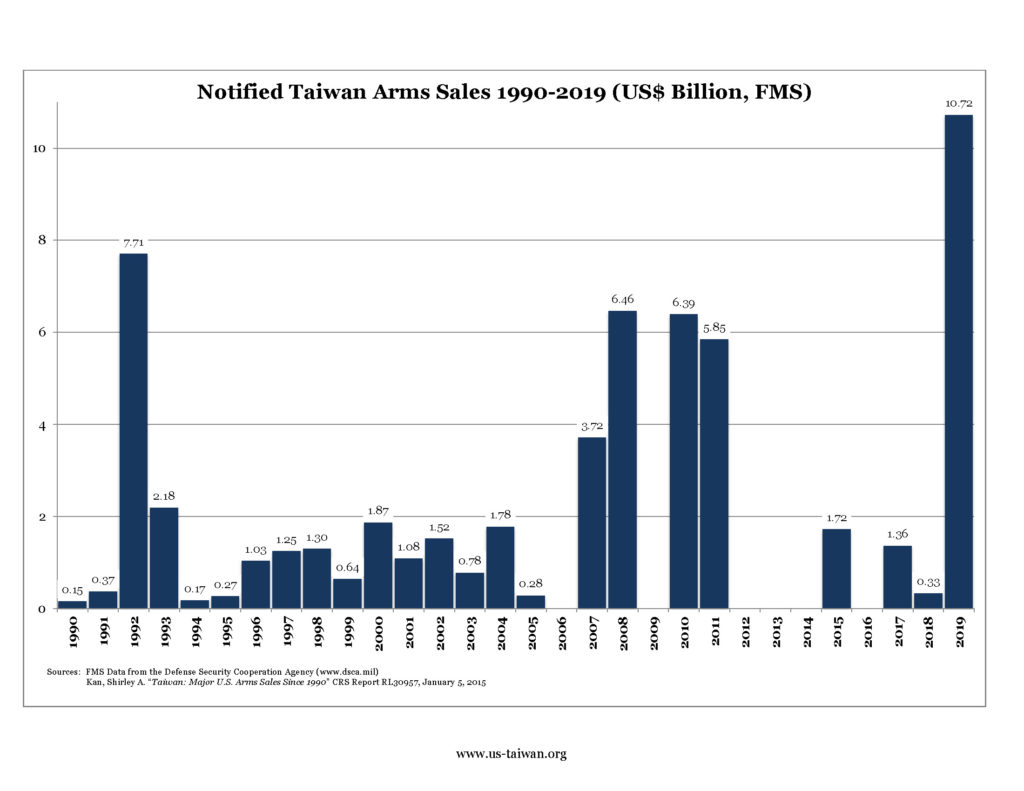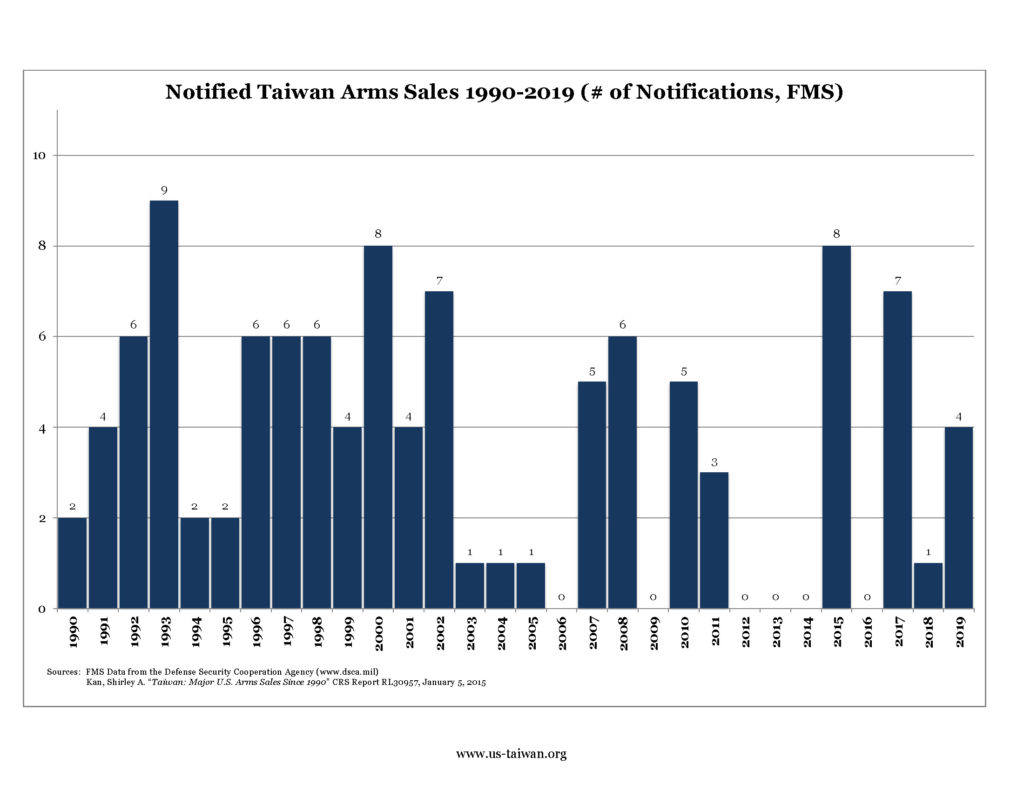Update, August 13, 2018
On this date, President Trump signed the John S. McCain National Defense Authorization Act for Fiscal Year 2019 into law (Public Law No: 115-232).
Update, August 3, 2018
On this date, Congress submitted the 2019 NDAA to the President for signature. The following Taiwan-related language was included in the final version of the bill:
SEC. 1257. Strengthening Taiwan’s Force Readiness.
(a) DEFENSE ASSESSMENT. – The Secretary of Defense shall, in consultation with appropriate counterparts of Taiwan, conduct a comprehensive assessment of Taiwan’s military forces, particularly Taiwan’s reserves. The assessment shall provide recommendations to improve the efficiency, effectiveness, readiness, and resilience of Taiwan’s self-defense capability in the following areas:
(1) Personnel management and force development, particularly reserve forces.
(2) Recruitment, training, and military programs.
(3) Command, control, communications and intelligence.
(4) Technology research and development.
(5) Defense article procurement and logistics.
(6) Strategic planning and resource management.
(b) REPORT REQUIRED. –
(1) IN GENERAL. – Not later than 1 year after the date of the enactment of this Act, the Secretary of Defense, in consultation with the Secretary of State, shall submit to the appropriate congressional committees a report containing each of the following:
(A) A summary of the assessment conducted pursuant to subsection (a).
(B) A list of any recommendations resulting from such assessment.
(C) A plan for the United States, including by using appropriate security cooperation authorities, to–
(i) facilitate any relevant recommendations from such list;
(ii) expand senior military-to-military engagement and joint training by the United States Armed Forces with the military of Taiwan; and
(iii) support United States foreign military sales and other equipment transfers to Taiwan, particularly for developing asymmetric warfare capabilities.
(2) APPROPRIATE SECURITY COOPERATION AUTHORITIES – For purposes of the plan described in paragraph (1)(C), the term “appropriate security cooperation authorities” means–
(A) section 311 of title 10, United States Code (relating to exchange of defense personnel);
(B) section 332 such title (relating to defense institution building); and
(C) other security cooperation authorities under chapter 16 of such title.
(3) APPROPRIATE CONGRESSIONAL COMMITTEES. – In this subsection, the term “appropriate congressional committees” means–
(A) the congressional defense committees; and
(B) the Committee on Foreign Relations of the Senate and the Committee on Foreign Affairs of the House of Representatives.
SEC. 1258. Sense of Congress on Taiwan.
It is the sense of Congress that –
(1) the Taiwan Relations Act (22 U.S.C. 3301 et seq.) and the “Six Assurances” are both cornerstones of United States relations with Taiwan;
(2) the United States should strengthen defense and security cooperation with Taiwan to support the development of capable, ready, and modern defense forces necessary for Taiwan to maintain a sufficient self-defense capability;
(3) the United States should strongly support the acquisition by Taiwan of defensive weapons through foreign military sales, direct commercial sales, and industrial cooperation, with a particular emphasis on asymmetric warfare and undersea warfare capabilities, consistent with the Taiwan Relations Act;
(4) the United States should improve the predictability of arms sales to Taiwan by ensuring timely review of and response to requests of Taiwan for defense articles and defense services;
(5) the Secretary of Defense should promote Department of Defense policies concerning exchanges that enhance the security of Taiwan, including—
(A) opportunities for practical training and military exercises with Taiwan; and
(B) exchanges between senior defense officials and general officers of the United States and Taiwan
consistent with the Taiwan Travel Act (Public Law 115-135);
(6) the United States and Taiwan should expand cooperation in humanitarian assistance and disaster relief; and
(7) the Secretary of Defense should consider supporting the visit of a United States hospital ship to Taiwan as part of the annual “Pacific Partnership” mission in order to improve disaster response planning and preparedness as well as to strengthen cooperation between the United States and Taiwan.
Update, July 23, 2018
On this date, the conference report, reconciling the House and Senate versions of the bill, was filed. The conference report was agreed to in the House on July 26, 2018 and in the Senate on August 1, 2018.
The conference report notes:
Strengthening Taiwan’s force readiness (sec. 1257).
The House bill contained a provision (sec. 1253) that would direct the Secretary of Defense to conduct a comprehensive assessment, in consultation with appropriate counterparts of Taiwan, on ways to enhance and reform Taiwan’s military forces, particularly Taiwan’s reserve forces. The provision would also require that the assessment include recommendations to strengthen bilateral cooperation and improve Taiwan’s self-defense capabilities. The provision would require the Secretary of Defense, in consultation with the Secretary of State, to submit a report on the assessment and a list of recommendations and planned actions to the appropriate congressional committees not later than 1 year after the date of the enactment of this Act.
The Senate amendment contained no similar provision
The Senate recedes
Sense of Congress on Taiwan (sec. 1258)
The Senate amendment contained a provision (sec. 1243) that would express the sense of the Senate on the importance of a strong U.S. defense relationship with Taiwan.
The House bill contained no similar provision.
The House recedes with an amendment that would clarify that the provision expresses the sense of the Congress. The amendment would also clarify that the Secretary of Defense should promote Department of Defense policies concerning exchanges that enhance the security of Taiwan, including opportunities for practical training and military exercises with Taiwan.
Senior Defense Engagement with Taiwan
The House bill contained a provision (sec. 1262) that would express the sense of Congress that, pursuant to the Taiwan Travel Act (Public Law 115-135), a service secretary or member of the joint chiefs should visit Taiwan for a senior-level defense engagement.
The Senate amendment contained no similar provision.
The House recedes.
Update, June 18, 2018
On this date, the U.S. Senate passed its version of the John S. McCain National Defense Authorization Act for 2019 by Yea/Nay Vote of 85 – 10.
Update, April 13, 2018
The NDAA, as H.R.5515, was introduced in the House on April 13, 2018. On May 24, the U.S. House of Representatives passed its version of the National Defense Authorization Act for 2019.





